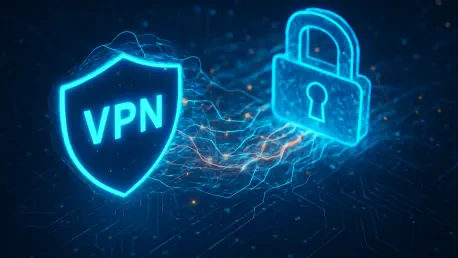Picture a future where the most guarded secrets—banking information, private communications, or critical business strategies—could be exposed in mere hours by a revolutionary type of computer. This isn’t a far-fetched plot from a sci-fi novel; it’s the potential reality of quantum computing, a technology with the power to dismantle the encryption standards that protect our digital lives today. As this threat looms on the horizon, a new defense known as post-quantum encryption (PQE) is emerging to counter it. Virtual Private Networks (VPNs), widely used for online privacy, are beginning to integrate PQE as a safeguard against this futuristic danger. Yet, for the average user, the question remains: why should something so seemingly distant matter now? The answer lies in grasping the profound implications of quantum advancements and the proactive measures being taken to secure data. Understanding this shift is essential, as it touches on both future risks and the vulnerability of information already encrypted, urging a closer look at how digital security is evolving.
The Quantum Threat to Data Security
Quantum Computing’s Potential to Break Encryption
The core of the concern with quantum computing is its staggering potential to crack encryption methods that have long been considered unbreakable, such as AES-256, posing a significant threat to digital security. Unlike traditional computers that process information in a linear, bit-by-bit fashion, quantum machines leverage quantum bits, or qubits, to perform multiple calculations simultaneously. This exponential leap in processing power could solve complex mathematical problems—like factoring large prime numbers—that underpin current encryption, reducing decryption times from millions of years to just hours. Such a capability would render much of today’s secure data, from personal records to governmental communications, dangerously exposed. While this technology isn’t fully realized yet, the theoretical foundation is already causing alarm among cybersecurity experts who foresee a future where digital privacy could be fundamentally compromised if new defenses aren’t developed swiftly.
Beyond the theoretical threat, the impact of quantum computing on encryption extends to every corner of the digital world, affecting individuals, businesses, and entire nations. If quantum computers become operational at a scale capable of breaking AES-256, the fallout could include massive data breaches, financial losses, and eroded trust in online systems. Encryption isn’t just a technical detail; it’s the bedrock of secure internet transactions, protecting everything from e-commerce to confidential emails. The urgency to prepare for this shift stems from the sheer scale of what’s at stake—once quantum decryption becomes possible, there may be little time to react. This looming challenge has spurred global efforts to rethink how data security is approached, pushing for innovations that can withstand such unprecedented computational power and ensure that the digital infrastructure remains resilient in the face of emerging technologies.
The Risk of Harvested Data
A particularly unsettling strategy known as “harvest now, decrypt later” adds another layer of urgency to the quantum threat, highlighting the looming danger to data security. Malicious actors, whether individual hackers, organized groups, or even state-sponsored entities, could be amassing encrypted data today with the intent to decrypt it in the future using quantum tools. This means that information secured with current encryption standards isn’t safe in the long term; it’s merely in a holding pattern until technology catches up. Personal data, corporate trade secrets, and sensitive government files collected now could all become accessible down the line, creating a ticking time bomb for privacy and security. The inability to retroactively protect already encrypted data underscores the need for forward-thinking solutions that can secure new information against such future risks, as the scale of potential exposure grows with every passing day.
This concept of data harvesting also highlights a critical asymmetry in cybersecurity risks, emphasizing the uneven playing field between individuals and larger entities. While the average person or small business may not face an immediate quantum threat, larger organizations with access to vast resources could exploit this strategy much sooner. Historical data, once thought to be secure indefinitely, becomes a liability if stored without updated protections for the future. This scenario paints a grim picture where past communications or transactions, long buried in encrypted archives, could resurface as vulnerabilities. Addressing this issue requires not only developing new encryption methods but also raising awareness about the long-term implications of data storage. As quantum computing progresses, the focus must shift to minimizing the amount of sensitive information left exposed to eventual decryption, prompting a reevaluation of how data lifecycles are managed in both personal and professional contexts.
Understanding Post-Quantum Encryption (PQE)
What Makes PQE Different?
Post-quantum encryption represents a bold departure from traditional methods like AES-256, offering a suite of algorithms specifically engineered to resist the computational power of quantum machines. Unlike the standardized approach of current encryption, which relies heavily on the difficulty of factoring large numbers, post-quantum encryption encompasses diverse cryptographic techniques developed by various global teams. These methods are built on mathematical problems believed to be resistant to quantum solving capabilities, though they remain largely theoretical since no quantum computer exists to fully test them. Spearheaded by organizations like the National Institute of Standards and Technology (NIST), alongside contributions from tech giants, post-quantum encryption is a collaborative effort to future-proof data security. While it lacks the decades of real-world validation that bolster confidence in existing standards, it stands as a critical line of defense being crafted for an uncertain digital tomorrow.
The distinction of PQE also lies in its proactive nature, addressing a threat that hasn’t fully materialized but is widely anticipated, making it a forward-thinking strategy in the realm of cybersecurity. This innovative approach, while groundbreaking, carries inherent uncertainties—without practical quantum adversaries, the effectiveness of these algorithms remains a calculated hypothesis. Experts are navigating uncharted territory, balancing the need for robust security with the reality that these solutions might require years of refinement. For users, this means that while PQE holds promise, it isn’t a guaranteed shield yet; it’s a work in progress driven by the urgency to stay ahead of technological breakthroughs. As research continues, the development of PQE serves as a reminder of the evolving nature of cybersecurity, where anticipating risks is just as vital as responding to them, ensuring that the digital landscape can adapt to challenges that are still on the horizon.
VPNs and the Push for PQE
VPN providers are increasingly integrating PQE into their services, marketing this adoption as a sign of cutting-edge commitment to user privacy. By incorporating these emerging encryption methods, they aim to position themselves as leaders in preparing for quantum threats, offering a layer of protection that anticipates future vulnerabilities. However, the practical benefits of PQE in VPNs are not yet concrete—without operational quantum computers to test against, the real-world strength of these measures remains speculative. This adoption is less about immediate security gains and more about signaling readiness for a paradigm shift in how data is protected. For consumers, this move by VPNs underscores the importance of choosing services that prioritize long-term security strategies, even if the tangible impact of such features is still pending validation.
Moreover, the integration of PQE by VPNs reflects a broader trend in the cybersecurity industry to address potential risks before they become crises. While this step is commendable, it also raises questions about the balance between innovation and proven reliability. Users must recognize that PQE-enhanced VPNs are not a silver bullet against quantum threats at this stage; they are part of an ongoing experiment in safeguarding data. The focus for VPN providers appears to be on building trust through forward-thinking practices, ensuring they remain relevant as encryption standards evolve. As this technology matures, the role of VPNs in bridging current security needs with future protections will likely become clearer, but for now, their adoption of PQE serves as an early indicator of the direction in which digital privacy tools are heading, emphasizing preparedness over immediate resolution.
The Reality of Quantum Computing Today
Where Does Quantum Tech Stand?
Quantum computing, while a groundbreaking concept, remains confined to experimental stages within advanced research facilities operated by major corporations and academic institutions. The technology faces significant obstacles, including immense power requirements, challenges in error correction, and difficulties in scaling systems for practical use. Unlike conventional computers, quantum systems are not yet stable or accessible enough to pose a direct threat to encryption on a wide scale. Expert opinions vary widely on the timeline for viable quantum machines capable of breaking current standards, with estimates ranging from a few years to several decades. This uncertainty suggests that while the potential for disruption exists, it is not a pressing concern for most users or organizations, allowing time for the development of countermeasures like post-quantum encryption (PQE) to keep pace with these advancements.
Additionally, the current state of quantum computing highlights the significant gap between theoretical capabilities and real-world application, underscoring the challenges in bridging this divide for practical use. Even the most advanced quantum systems today are far from achieving the computational power needed to decrypt robust encryption like AES-256. High-profile projects in this field are often limited to controlled environments, requiring specialized conditions that are impractical outside of research settings. This slow progress provides a buffer for cybersecurity experts to refine protective measures, but it also means that public perception of quantum threats can sometimes outpace reality. For now, the focus remains on overcoming technical barriers, with the understanding that widespread availability of quantum technology is still a distant prospect. This ongoing development phase offers a window of opportunity to strengthen digital defenses before such machines become a tangible risk to global data security.
Who Might Get There First?
Even if quantum computing isn’t broadly accessible in the near term, the possibility of early adoption by powerful entities such as governments or large tech corporations introduces a significant concern. These organizations often have the resources and motivation to accelerate development, potentially gaining quantum decryption capabilities before the technology reaches the general public. Such an imbalance could create scenarios where sensitive data—whether personal, corporate, or national—is targeted by those with exclusive access, leaving others defenseless. This disparity underscores a critical risk in the cybersecurity landscape, where the uneven distribution of cutting-edge tools might exacerbate existing vulnerabilities and create new power dynamics in the digital realm, long before quantum threats become a universal issue.
The implications of this early access extend beyond mere technical advantage, raising ethical and security questions about how such capabilities might be used, especially if state actors or major corporations wield quantum decryption tools first. The potential for misuse—whether for surveillance, economic espionage, or other strategic gains—becomes a pressing concern. Smaller entities and individuals, lacking comparable resources, would be disproportionately affected, unable to counter these advanced threats. This scenario emphasizes the importance of global cooperation in developing and standardizing post-quantum encryption (PQE), ensuring that protective measures are accessible to all rather than concentrated among a few. As quantum research progresses, monitoring who gains early mastery over this technology will be crucial, as it could shape the future of data privacy and security in ways that are difficult to predict or mitigate after the fact.
Balancing Future Fears with Present Needs
Today’s Threats Matter More
While the specter of quantum computing looms large, it’s vital not to let it overshadow the immediate cybersecurity challenges that impact users every day, such as phishing attacks, ransomware, data breaches, and weak password practices. These issues pose real, tangible risks that exploit vulnerabilities right now, often with devastating consequences. These threats don’t require futuristic technology to wreak havoc; they thrive on human error and inadequate defenses, draining finances and compromising privacy on a massive scale. Fixating on a distant quantum danger risks diverting attention from these pressing issues, which demand robust, actionable responses. Understanding post-quantum encryption (PQE) is valuable for long-term awareness, but it offers no solution to the scams and leaks that dominate the current landscape of online risks, making present-day vigilance the priority.
Furthermore, the scale and immediacy of today’s cyber threats far outweigh the hypothetical impact of quantum decryption for most individuals and businesses, making it a pressing concern that demands urgent attention over future possibilities. Criminals exploiting social engineering tactics or unsecured networks aren’t waiting for advanced quantum tools—they’re capitalizing on existing weaknesses with alarming efficiency. Statistics show that data breaches and identity theft continue to rise, fueled by tactics that prey on a lack of awareness or outdated security protocols. Addressing these problems requires a focus on education, updated software, and proactive habits, rather than relying on future encryption innovations to solve all issues. The reality is that while preparing for quantum challenges is prudent, the bulk of effort must target the battles being fought online today, ensuring that foundational security isn’t neglected in favor of speculative concerns.
Practical Steps You Can Take
In light of the distant nature of quantum threats, the emphasis for most users should be on implementing proven cybersecurity practices that guard against current dangers, ensuring a robust defense against immediate risks. Strengthening passwords by using complex, unique combinations for each account is a fundamental step, as is enabling two-factor authentication wherever possible to add an extra layer of protection. Employing a reputable VPN can also shield online activity from prying eyes, especially on public networks. These measures directly combat prevalent risks like hacking attempts and data interception, which are far more likely to occur than a quantum breach in the foreseeable future. By prioritizing these straightforward actions, users can build a solid defense against the most common and immediate threats, maintaining control over personal and professional data security.
Additionally, staying cautious about online behavior forms a critical part of this practical approach. Avoiding suspicious links, regularly updating software to patch vulnerabilities, and being mindful of sharing sensitive information can thwart many attacks that don’t rely on advanced technology. These habits, while simple, are often overlooked, yet they form the first line of defense against cybercriminals seeking quick wins through deception or exploitation. Unlike quantum-related risks, which remain beyond individual control at this stage, these steps empower users to actively reduce exposure to harm. As the tech industry continues to grapple with future encryption challenges, adhering to these basics ensures that day-to-day safety isn’t compromised, providing a stable foundation while more complex solutions like post-quantum encryption (PQE) are refined and tested over time.
Staying Informed for Tomorrow
Looking ahead, keeping abreast of developments in post-quantum encryption (PQE) and quantum computing equips users to navigate the shifting terrain of digital security with greater confidence. Following updates from trusted sources about how encryption standards are evolving, and observing how VPN providers adapt to these changes, offers insight into what might be required for future protection. This knowledge doesn’t demand immediate action but fosters a proactive mindset, preparing individuals to make informed decisions as new tools and threats emerge. Awareness of these trends ensures that when quantum risks become more concrete, or when PQE becomes a validated standard, users aren’t caught off guard by the need to update their security practices, maintaining a balance between current safety and future readiness.
Moreover, staying informed about these advancements also helps in distinguishing genuine security innovations from marketing hype. As VPNs and other services promote post-quantum encryption (PQE) integration, understanding the underlying technology and its limitations prevents overreliance on unproven solutions. Engaging with credible discussions on cybersecurity forums or through expert analyses can clarify the practical implications of quantum progress and the timeline for its impact. This ongoing education serves as a bridge between today’s actionable steps and tomorrow’s potential challenges, ensuring that users remain adaptable in a landscape where threats and defenses are constantly evolving. By cultivating this awareness, the groundwork is laid for adapting to significant shifts in how online privacy is protected, aligning personal habits with the broader direction of technological change.









